![]()
A N C E S T R A L C I T Y
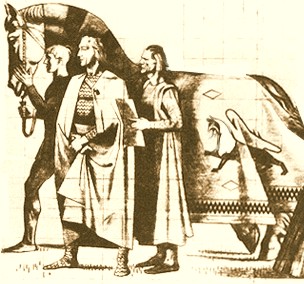
A LAND WITHOUT RUINS IS A LAND WITHOUT MEMORIES --
A LAND WITHOUT MEMORIES IS A LAND WITHOUT HISTORY...
-- ABRAM JOSEPH RYAN
Written by Gevork Nazaryan
The great city of Ani is very dear to my heart, for my forefathers lived here many centuries ago. According, to the Nazaryan [lit. Seer -- Azgn Višapac‛ -- Supreme Scion] family genealogical historian, Eli Nazarian (Nazareannerĕ, The Nazaryans, published in Beirut in 1988), one of the last families to leave Ani, was the family of the master goldsmith Nazar Nazaruni in 1475. The centuries-long tradition of master goldsmiths continued all the way to the present with, two of my eldest uncles -- Andranik and Gevork -- continuing the excellent tradition of our ancestors, my Father -- the fourth son of five brothers -- became a surgeon. According to E. Nazarian, the Nazaruni family later on branched out and formed the rather populous supra-family of Nazarians, spread throughout Eastern Armenia, Western Armenia and Cilician Armenia. Some branches of the family eventually established themselves in Artsakh, the Easternmost Gates of Eastern Armenia. The Shahnazarian meliks during late Middle Ages formed one of the 5 melikdoms or noble houses of Artsakh. Others such as Gyulnazarians (adopting the Rose -- the eternal female principle -- as the Family Symbol) established themselves in the famous merchant city of Julfa, in the Nakhichevan province of Eastern Armenia. The established close ties with the Persian Shahs. Later on some members of the family moved to New Julfa in Iran. Another famous branch of the Nazaryan/Nazarian family were the Lazarians/Lazaryans (some also used the Ghazarian last name -- l-gh transition), who by the XVIIIth century had established themselves in Moscow and St. Petersburg, and were granted and recognized as prominent nobles of the Russian Empire by the Romanoffs.
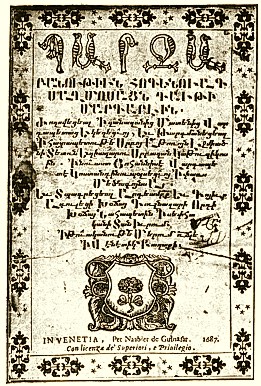
A PAGE FROM THE BOOK OF ELUCIDATION PUBLISHED
IN VENICE IN 1687 BY NAHAPET NAZAREAN
THE FRONTISPIECE BARES -- THE RED ROSE
SUPERIMPOSED ON A SHIELD -- THE FAMILY INSIGNIA.

1916 SKETCH OF THE MOTHER CHURCH OF ANI
FROM A STUDENT YEARBOOK
The Lazarians were philanthropists when it came to aiding the poor and needy. They worked tirelessly to see the liberation of Armenia from foreign yoke and hoped for an eventual restoration of the Armenian State. They build, new schools, seminaries, churches and established a university that became an important Armenian spiritual and as well as educational center. The Nazarian/Nazaryan family was famous for its active role in the trade and merchant business, names such as Nazar the mayor of Jugha and Manuk the treasurer of Julfa, sons of Nazar Nazaruni established themselves in the Persian royal court and were respected throughout the region by the people of the province of Goghtan, Nakhichevan in Eastern Armenia. It is from this branch that my ancestry of the Nazaryan family derives (tracing it with the genealogical charts provided by Eli Nazarian, and the relative of Eli, from my extended family, that gave me the book - my direct lineage being traced to as far back as around 1750), who in the XVIIIth and XIXth century moved to Aintab and K‛ilis in Cilician Armenia, where they lived and worked until the early 1920s of the XXth century...

PORTRAIT OF I.L. LAZARIAN BY VASILY TROPININ [1822]
I.L. HOLDS THE ARCHITECTURAL PLANS FOR THE
NEW LAZARIAN SEMINARY IN MOSCOW
[THIS HISTORIC AND BEAUTIFUL NEO-CLASSICAL BUILDING IS
CURRENTLY HOME OF THE RA EMBASSY IN THE RUSSIAN FEDERATION] --
THE SEMINARY SOON AFTER ITS ESTABLISHMENT
BECAME A MAJOR CENTER OF HIGHER EDUCATION.
THE HIGHLY PHILANTHROPIC LAZARIAN FAMILY ALSO HEADED THE
THE NATIONAL LIBERATION MOVEMENT

THE LAZARIANS. FAMILY PORTRAIT CIRCA 1820.
...In 1919 the Armenians, survivors of the horrific Genocide at the hands of the Turks hoped to build, a New Armenia, an Armenia Reborn... During this period in the East, another group of surviving Armenians were fighting off the Turkish armed criminal gangs that had forever seized being a disciplined army but were more like a pack of vultures looking for "easy" preys (prospect of looting of goods without actually working, rape, kidnapping of women being their chief motives of the Turkish "army" in killing Armenians in the East and the West.)
Meanwhile, in the West, in Cilician Armenia, brave Armenian men and women fought for their survival and for Life itself. The Turkish brigands launched a massive offensive against the Armenians of Cilicia to "finish" the job of the Genocide. One of the heroic self-defense battles that took place from 1920-21, was the Battle of Aintab (the Turks later made the massacre a "national holiday" and renamed the city "Brave Aintab..."), which lasted for a total of three hundred and fourteen days.
DEATH TO TYRANNY AND TYRANTS ! --
TORMENTERS AND KILLERS OF OTHER HUMAN BEINGS
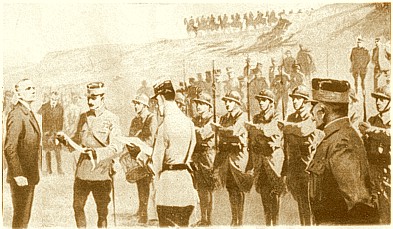
THE VOLUNTEER FIGHTERS OF THE ARMENIAN LEGION WERE BY FAR THE
BEST SOLDIERS OF THE FOREIGN LEGION PARTICULARLY DISTINGUISHING
THEMSELVES IN THE VICTORY OVER THE TURKISH HORDES IN THE
BATTLE OF ARARA IN PALESTINE.
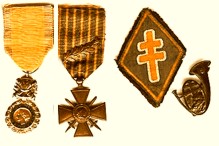
MEDALS, BADGE AND PATCHES OF AN ARMENIAN
LEGIONNAIRE...
FROM THE SITE DEDICATED TO THE HEROES OF THE ARMENIAN LEGION...
WHO SCORED A NUMBER OF EPIC VICTORIES AGAINST INVADING TURKS.
THE PATCH AND THE BADGE STAND FOR LUSIGNAN SCION
CROSS OF CILICIAN ARMENIA/LORRAINE...
THE VERY FIRST PICTURE INSIDE THE AWE INSPIRING ARC DE TRIUMPHE [AT THE
TOP OF STAIRS] -- IN THE HEART OF PARIS -- IS THE PICTURE OF ARMENIAN
VETERANS MARCHING WITH ARMENIAN AND FRENCH TRICOLORS...

THE COVER OF THE EXTENSIVE HISTORY OF NAZARIAN FAMILY.
FROM
1475 TO PRESENT [PUB. IN 1988]. ELIE H. NAZARIAN, BEIRUT.

OFFICIAL KONDAK [PARALLEL OF PAPAL BULL] OF H. H. CATHOLICOS
VAZGĒN I [ISSUED AND SIGNED ON OCTOBER 12,
1972] TO
BROS. NAZAR, NUBAR AND LEVON NAZARIAN FOR ERECTING
THE QUINTESSENTIAL AGBU CULTURAL-EDUCATIONAL
CENTERS THROUGH MYRIAD OF ORGS SUCH AS AYA.
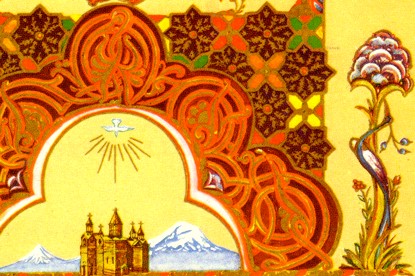
THE VARDEAK [ROSETTE] AND THE SIRAMARG
[PEACOCK THE BIRD OF DIVINE
LOVE] AND THE TREE OF LIFE ANCIENT TRADITIONAL ANCESTRAL SYMBOLS OF THE
SACREDNESS OF FERTILITY/LIFE ON THE CATHOLICOSAL DECREE. HOLY SPIRIT
IN THE FORM OF WHITE DOVE [SYMB. OF THE GODDESS] 11 RAYS DESCEND
[LIT. ECHMIAZIN] INTO THE MOTHER CATHEDRAL OF THE HOLY SEE CENTERED
BETWEEN THE TWIN PEAK-BREASTS OF TWIN PEAK COSMIC MOUNTAIN AR.AR.AT.
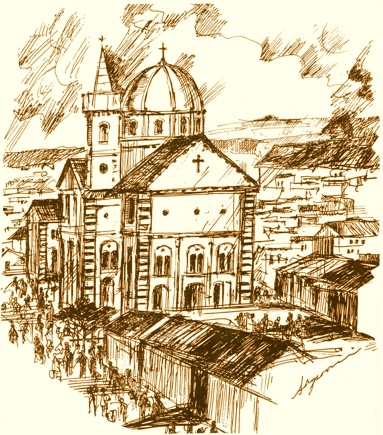
THE GREAT LANDMARK OF AINTAB [FROM WHERE MY GRANDMOTHER
HAILS...
AN IMPORTANT STRONGHOLD OF NAZARYAN CLAN IS THE ARMENIAN ST. MARY'S
CATHEDRAL, WHICH TOOK THIRTY YEARS TO BUILD. SINCE 1915, THE TURKS
HAVE USED THIS GREAT CHURCH AS A JAIL...AND LATER CONVERTED
THE CHURCH INTO A MOSQUE...
The Turks thought that when the French troops pull out of Cilicia, the
Armenian population would leave with the French who were viewed as a
"protective" force that would possibly serve as a occupying power, if given a
mandate to administer the region by the Allied General Command. They were wrong.
Many of the Armenians served in the French Foreign Legion, in the elite, almost
exclusively Armenian corps -- the Armenian Legion or the Eastern Legion (fought
primarily in severe battles for Near East). The memories of the Armenian
Genocide, where most of their relatives were slaughtered were still fresh in
their minds and they were simply full of severe antipathy toward the armed
Turks.

FAMILY DIAMOND OF THE PERFECTED HIGH SPIRIT
The Armenians of Aintab as well as other Cilician cities decided
to die fighting rather then surrender or leave their ancestral homeland. A
fighting unit of only 750 men was organized most of whom were experienced
fighters and had previously served in the Foreign Legion and as well as local
militia was formed and the major entries to the city were barricaded. The small
Armenian force had to fight enormous odds and stood against a Turkish Army. Just
as Armenians crushed and with it the myth of one of the "best" Turkish Armies (
The so called "Galibolu" Army that supposedly was never defeated by the Allies)
in the life and death Battle of Sardarapat so did the Aintabts'is fought and
defeated the "battle hardened" (they were expecting an "easy kill," when men
were not there to defend the butchery of women and children) Turks of the
Armenian Genocide ( after the Turks themselves admitted that they preferred to
fight defenseless women and children then Armenians in arms). The Turks were
mostly looking for the promised war booty and not seeing the serious danger of
shortening their life with such Turkish "military" way of life. Led by the
incompetent and weak leadership of corrupt Turkish officers they were defeated
by a militia of determined Armenian men and women whose backs were turned to the
wall. Many members of my family participated in the fighting, my grandmother was
wounded while rushing ammunition and food to her brother on the barricades.
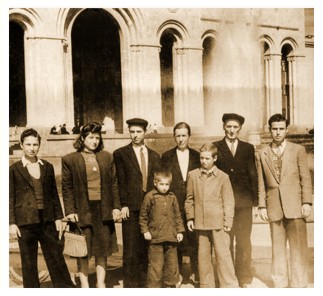
THE NAZARYAN FAMILY. YEREVAN, 1949. REPUBLIC SQUARE.
MR. & MRS. HAKOP AND OVSANNA NAZARYAN WITH THEIR
SIX CHILDREN -- FIVE BROTHERS AND SISTER ALICE
FROM LEFT TO RIGHT -- GRIGOR, ALICE, ANDRANIK [ELDEST SON],
ARSEN [YOUNGEST SON -- SARKIS' FATHER], OVSANNA, PARKEV [MY FATHER], HAKOP,
GEVORK
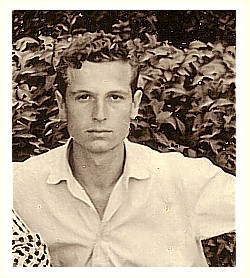
F A T H E
R. C I R C A 1
9 5 6.
The Aintabtsis did held out (thanks to mostly the men of the Legion) until they were asked by the temporary government of Cilicia to leave Aintab and withdraw towards the Syrian border. After many of the Cilician cities fell to numerically overwhelming Turkish forces, who paid a high price and lost thousands of men in their occupation drive. Aintapts'i and the branched out Kilistsi Nazaryans along with many of their Cilician compatriots left Aintab and settled in the Syrian border town of Azaz (Azez). In 1946, in the wake of the Great Repatriation drive, my grandfather Hakop Nazaryan with his wife Ovsanna and five sons, Andranik the eldest (the name implying the firstborn...and...the great Defender and National Hero -- Major General Andranik Ozanian), Gevork [or Gēorg in classical form], Grigor, Parkev (my Father) and Arsen (the youngest -- Sarkis' father) and their sister Alice repatriated to Soviet Armenia. My father was 10 years old when they repatriated to Armenia. He enrolled in the Banerit [Young Workers] school No. 11. He continued his higher education by being accepted in the Yerevan's prestigous School of Medicine [one of the best in the Soviet Union] where he fell in love with one of his fellow female medical student colleagues.-- Aida Khachatryan -- a Yerevan localite originally from a proud highlander stock of warrior-teachers of the ancient Syunik province, more commonly known as Zangezur. The initially platonic relationship blossomed into a romance and eventually a marriage in 1969. I was born seven years later in -- on -- November 22, 1976. My mother through these years preserved the ID patch -- that reads 'Nazaryan - its a Boy' -- that was placed on my hand immediately after birth. Parkev was destined to become an outstanding surgeon -- a Healer of people -- performing a Herculean average of 300 operations per year.
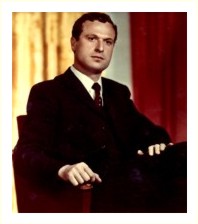
F A T H E R. C I R C A 1 9 7 1.
Thus the circle of the Nazaryan family came to its completion.
The Great city of Ani and Eastern Armenia were once home to my ancestors
starting with Nazar Nazaruni of Ani and the later the Nazaryans of Goghtan (Gołt'an)
and Artsakh, with some in the XVIIth century branching out and establishing
themselves in New Jugha and Isfahan.

FURTHER READING | HIGHLY RECOMMENDED:
VIRTUAL ANI -- A
TRULY GREAT SITE
SPECIFICALLY DEDICATED TO THE CITY OF ANI
http://www.virtualani.freeserve.co.uk/